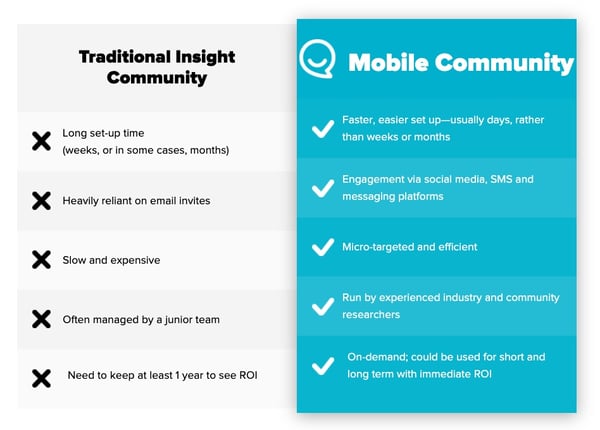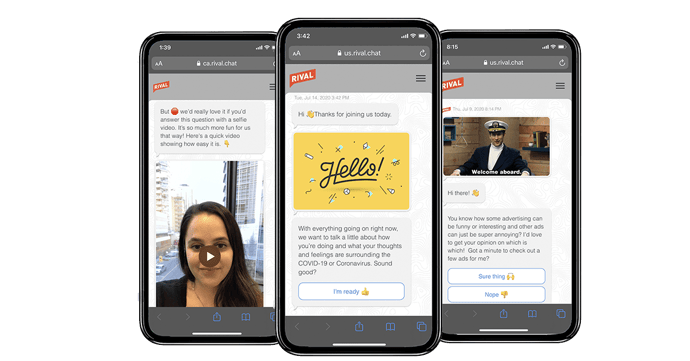If we put communities under the microscope we’ll find that the status quo is not without problems.
Insight communities as we know them today were first introduced in the early 2000s. Back then, the idea of recruiting a group of consumers who opted-in for ongoing engagement was revolutionary. Community-based research allowed brands to circumvent what was then new anti-spam laws by having an at-the-ready pool of people who could easily complete surveys, providing a degree of speed and efficiency that was unprecedented at a time when expensive landline-based survey techniques were the norm.
Today, insight communities are still in-demand. They’re so popular, in fact, that according to the 2019 GreenBook Research Industry Trends Report, research communities still have the highest level of interest amongst insights buyers, outranking mobile surveys and text analytics. For the most part, insight professionals still see research communities as a core tool for agile research.
Insight communities: A mainstream, useful tool with big challenges
As a lifelong researcher, I think it’s important to examine our current approaches to see if they are still relevant to how people are living their digital lives. If our techniques are disconnected with how people connect and communicate, we’re not going to get the authentic, representative feedback companies need to survive today’s highly competitive landscape.
And if we put communities under the microscope, we’ll find that the status quo is not without problems. For one, insight community platforms haven’t really evolved as quickly as they should. But more crucially, as an industry, our approach to community-based research hasn’t changed much either.
Insight community platforms haven’t evolved as quickly as they should.
Today, insight communities still heavily rely on aging market research technologies that are out of sync with how consumers live their digital lives. In the past decade, billions of consumers have adopted smartphone-enabled, mobile-first communications channels like SMS and social messaging apps. In contrast, most community-based research platforms still rely heavily on email survey deployments—an increasingly crowded channel that is rapidly being discarded by youth—to recruit and engage consumers. It’s no wonder it’s getting harder and harder to have an active, highly engaged community.
Beyond technology, we’re also contending with a philosophical evolution in the idea of how communities should be managed. In many organizations, research communities are a cumbersome initiative, requiring a full-time person to oversee set-up, recruitment, respondent engagement, incentives and everything else in between.
In many organizations, insight communities are a cumbersome initiative.
Further, long, boring surveys sent to community members are often repetitive and overly formal, using language no one would ever use in real life. (When was the last time you asked a family member, “On a scale of one to 10, where one is extremely dissatisfied and 10 is extremely satisfied, how would you rate our family life?”) Indeed, it is not surprising that traditional insight communities are seeing declining response rates as they have increasingly become massive walled gardens that require active, ongoing oversight to keep them healthy.
It's time to rethink insight communities
When I founded Reach3 in 2018, it was done with the belief that we’re entering a new era of online marketing research—one characterized by more authentic, natural and on-demand engagement with real people.
The idea is simple: Engage in real conversations using the messaging networks and apps that are already part of consumer’s everyday lives. Keep it human. No walled gardens and overly formalized research language. In other words, talk to research participants like they are people, not as merely “respondents.”
I did this with a firm belief that if we don’t address our industry’s reliance on long, boring email-based survey approaches, we’ll continue to see declining response and engagement rates and face more questions about the validity and representativeness of our results. It’s in our best interest to accelerate the evolution of our practice.
The last two years have been a period of rapid growth and learning for everyone at Reach3. During this time, we’ve worked with early adopters such as Snapchat, Jägermeister and Kimberly-Clark to find out how our industry can best capitalize on the mobile messaging revolution. We’ve seen massive success with our clients across a variety of projects, but one very exciting learning is on how we can leverage conversational, messaging-based technologies and techniques to re-engineer communities for the mobile-first era.
The future of communities—from the pioneers of community-based solutions
Today, I’m excited to share the official launch of our Mobile Community solution. Powered by software from our sister company Rival Technologies, this mobile-messaging based solution is purpose-built to help global brands capture the fast, iterative and ongoing insights they need to win in a rapidly changing world.
As you can see below, Mobile Communities address the major drawbacks of traditional, email-based consumer research techniques.

The results from these enhancements are compelling. For research participants, the experience is in-the-moment and more immersive. We break long research initiatives up into short, iterative exercises – with seamless mobile notifications letting community members know when to resume the conversation. Our incredibly high response and recontact rates (60%+) speak volumes about how engaging this type of research is for participants. In fact, research-on-research conducted by Rival Technologies found that people find the conversational survey experience easier and more fun and enjoyable to complete.

For brands, this mobile-first approach makes it easier to bring new voices into the research process, including hard-to-reach audiences like Gen Zs and Millennials. The ability to capture emotive video feedback in addition to robust and predictive quantitative data not only provides richness to your insights—it also helps market research teams gain more visibility in the C-suite, helping business leaders see the humans behind the data.
When answering conversational exercises, people let their guard down.
Perhaps more importantly, feedback from Mobile Communities is more candid and richer. As a Wall Street Journal article recently points out, people tend to be more honest when writing on their smartphones. When answering conversational surveys, people let their guard down—they abandon what we like to call “test-taking mode”—and share their more intimate thoughts and feelings. In an age when insight-driven businesses are outperforming their competitors, the ability to uncover the truth about people’s habits, motivations and attitudes is a huge competitive advantage.
In addition to building Mobile Communities for clients, we’ve also used our own solution to create an on-demand community tracking shifting sentiments and behaviors during COVID-19. Our clients have been receiving complimentary reports from this program called Consumer Closeness in the Age of Social Distancing, and the feedback so far has been very positive.
Let’s continue the conversation on Mobile Communities
We’re very excited to finally unveil our Mobile Community offer and to work with innovative market research teams in pushing our industry forward. If you’re interested in learning more, please check out our press release or download the information sheet here.

Matt Kleinschmit
CEO and Founder, Reach3 Insights







.webp?width=65&height=83&name=A-LIGN_HIPAA%20(1).webp)

